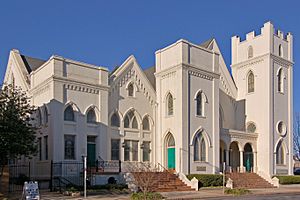Long View Center facts for kids
Quick facts for kids Long View Center |
|
|---|---|

Long View Center in 2008
|
|
| Religion | |
| Affiliation | Vintage Church |
| Status | Active |
| Location | |
| Location | Raleigh, North Carolina, United States |
| Architecture | |
| Architectural style | Neo-Gothic |
The Long View Center is an old church building in Raleigh, North Carolina, USA. It is part of the Moore Square Historic District. The building is right across from Moore Square, which is one of Raleigh's original parks from 1792.
This building was constructed between 1879 and 1881. It was first called Tabernacle Baptist Church. In 1998, a local developer bought the property. They changed its name to Long View Center. The idea was to use it for many different things. In December 2013, Vintage Church bought the building. Today, Vintage Church uses the main worship area, called the sanctuary, and the offices. Vintage Church Downtown holds its Sunday services there.
Contents
The Story of Long View Center
How the Church Started
In 1874, ten members left Raleigh's First Baptist Church. They started a new church called Swain Street Baptist Church. Their first building soon became too small. So, the members built a new, bigger church. This new building was at the corner of Person and Hargett Streets. They changed their name to Second Street Baptist Church. The new place opened in October 1881. In 1910, the church changed its name again to Tabernacle Baptist Church.
Helping the Community
During the Spanish flu outbreak in 1918, the church helped the city. They opened a soup kitchen in their 1880 Hall. They delivered over 2,000 meals to people in Raleigh. In the 1940s, during World War II, the church ran a center for servicemen. This center was in a building next to the main church. About 2,000 men visited the center during the war.
At this time, the church grew very big. It had almost 4,000 members. Tabernacle became the largest Baptist church in North Carolina. Because so many people joined, two more buildings were added to the property.
Changes Over Time
In the 1960s, many people started moving out of the downtown area. This is called suburbanization. As people moved away, the church's membership began to shrink. By the late 1990s, only about 650 members were left.
In 1998, the church decided to move to north Raleigh. They sold the property to a developer named Gordon Smith for $3.07 million. The Tabernacle members kept using the building until their new church was ready in 2001. In 2006, Gordon Smith rented the main worship area to Unity Church.
In December 2013, Gordon Smith sold the Long View Center to Vintage Church. Unity Church continued to use the building until June 2014. They then moved to their own new location. Vintage Church Downtown started its first service at the Long View Center on July 6, 2014. This happened after about a month of updates to the building.
Building Design and Style
The Long View Center has a mix of two building styles: Gothic Revival and Romanesque. When it was first built, it was a simple wooden structure. But it was updated many times in the early 1900s. The biggest changes happened in 1910.
The whole property has four buildings. They cover a total of 50,000 square feet (about 4,645 square meters). These buildings are called Freedoms Hall, 1880 Hall, North Carolina Hall, and Futures Hall.
Different Halls and Their Uses
Freedoms Hall is the original main worship area. It is next to Exploris Middle School. This hall has 64 stained glass windows. It also has a bell tower and a special room called a parlor. The sound in Freedoms Hall is naturally good for music and speaking. Most big events at Long View happen here.
The 1880 Hall is named after the year its dining hall was finished. This building has an art gallery. It also has a reception area and is used for smaller shows.
Futures Hall is a two-story office building that has been updated. North Carolina Hall has a Conference Room and more office spaces.
Vintage Church Today
Vintage Church uses the Long View Center for its main offices. It also houses the offices and ministry spaces for Vintage Church Downtown. The building is also a popular place for concerts and other events. For example, it has hosted parts of the Hopscotch Music Festival and the Wide Open Bluegrass Festival. It also holds art shows for events like First Night and First Friday.

